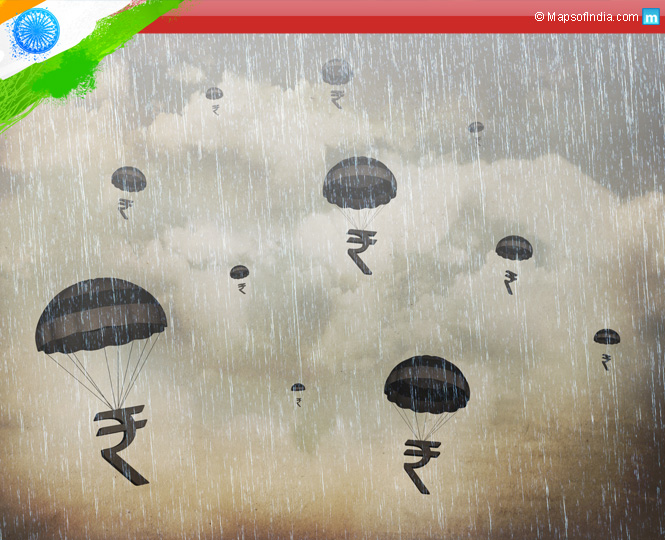Agriculture in India has always played a significant role in shaping the economy of the country. Speaking demographically, it is one of the largest economic sectors. In 2012-13, agriculture contributed to about 13.7 percent of the Gross Domestic Product (GDP). This is in sharp contrast to the 51.9 percent that agriculture had contributed in 1950-51.
Yes, the share of agriculture and its allies have been steadily decreasing over a period of years. Thanks to the shift from agriculture to the industries and services sector. But all said and done, about 50% of the population in India still remain employed in agriculture.
This is where monsoons come into the picture and assume a vital role. India receives maximum rains during the summer months – that is from June to September. And every year, without fail, the months of March and April witness heavy speculation regarding the fate of the monsoons. And there is no guessing on whom the entire focus shifts to – the Indian Meteorological Department (IMD). This is an agency that is under tremendous pressure to perform every year because most of the forecast of the economy lies on its predictions.
But is IMD equipped for high-level weather forecasts? It is interesting to note here that India still has a long way to go when it comes to monsoon forecasting. The IMD till date uses simple statistical methods, which may not yield accurate results all the time. However, this year it has implemented a new system of forecasting which hopefully will lead to correct predictions.
A quick look at what happens when there is a bad monsoon
When there is a bad monsoon, inflation raises its dirty head way too much. There is a sharp negative impact on the economy owing to the fact that about 50 to55 percent of the arable land in India depends on the rain. When monsoons don’t arrive on time, there is a delay in the sowing of summer crops like cereals, paddy, pulses, oil seeds, etc. This in turn has a negative impact on commodities that are dependent on the rain.
In case of inadequate rains, the yield is less, thus leading to an increase in the prices of the agriculture commodities and a lower turn around in the rural income. When rural income is less, the spending in the rural segment is cautious and curbed leading to lower consumption, thus affecting consumer goods and other companies who rely on rural spending for a share of their income. An increase in the prices of agricultural commodities boosts inflation, which in turn forces the Reserve Bank of India to raise the key lending rates.
Bad monsoon pulls the Indian economy into a vicious cycle and is mainly responsible for the increase in the number of famers committing suicides. Statistics reveal that farmer suicides account for 11.2 percent of suicides in India. Bad monsoons can really spell bad times for India.
Having said that, there are few who believe that monsoons need not be directly linked to inflation. A recent study revealed that India is not too dependent on rains as it used to be in the early 70s and that the country has progressed from a technological perspective and is better equipped to handle ‘drought-like’ and ‘extensive-rains’ situations.
A look at how India tackles bad monsoons
In view of bad monsoons, contingencies’ plans are prepared at various levels. State Departments of Agriculture come up with action plans to tackle various amounts of rainfall in their respective states. In their plans, they include budgetary support for the implementation of the plans too. First and foremost, during bad monsoons, the crop situation is continuously monitored. Seeds of alternate crops are made available, in case there is a delay in the monsoons and the farmers have to plant other crops. Seed banks are made available at the villages so that the seeds that suit the contingency plan are readily available at a local level. The areas vulnerable to drought are provided with drought tolerant crops. The farmers are also guided to tackle bad monsoons by way of trainings. They are given demonstrations on climate resilient agronomic practices and are taught about direct seeding options in case of delayed monsoons. They are also provided with farming equipments that will be used in drought-like situations. Rain water harvesting is promoted and the farmers are taught how to use the harvested water in the most-effective manner. In areas where there are floods or heavy rains, river bank protection activities are undertaken. The farmers are also guided on weather insurance so as to minimize the risks they are exposed to during bad monsoons.
2014: Indian economy and the monsoons
In April 2014, there was a warning that the El Nino, which is a periodical warming of the Pacific Ocean, may disrupt the monsoon rains this year. India, which usually receives the rains by the first week of June may see a delay lasting for several days. Not just the delay, but prediction had it that the rains would be insufficient, way below normal. This led to the Reserve Bank of India issuing a warning that bad monsoons would boost inflation nationwide.
That was in the month of April, but now in the month of July, El Nino conditions are no longer as threatening as April. They have eased out, prompting a withdrawal in the El Nino alert by the weather bureau.
So, can India rejoice? Not yet. The weather bureau has downgraded the alert to 50% from 70%, which means the threat still remains. As the Pacific continues to be warm, there have been typhoon formations in South-east Asia. Now, it will depend on the movement of these typhoons as to whether India will receive decent monsoon rains. However, there are strong expectations that the weather conditions would improve and India would receive normal monsoons – leading to a beautiful tango between the monsoons and the Indian economy.
Read More:
What is GST: How will it change India
Sensex, Rupee Vs Dollar, and Gold Rate – Do they reflect our economic outlook?
Is India Heading Towards Another Economic Crisis?
Positive signs for Indian economy – what does it mean?
Important facts about Indian Economy
Rupee Free Fall: Cause and Consequence
Why is the Indian Rupee Depreciating?
Investment Risks to Economy – Caution Is the Watchword for RBI
Economic Reforms in India: BJP Government Keen on Taking Tough Calls
A Parallel Economy of Bribe
FDI Norms for NRIs Relaxed – Foreign Investments Anticipated
Will India be affected by the Crisis in Greece?
Effects of Poor Monsoon on the Indian Economy and various sectors
How Inward Remittances impact the Indian Economy






